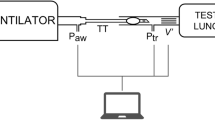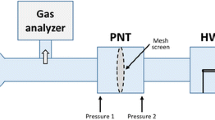Abstract
Study Objectives
The aim of this study was to measure the flow and volume dependence of both the ohmic and the viscoelastic pressure dissipations of the normal rat respiratory system separately during inflation and deflation.
Method
The study was conducted in the Respiratory Physiology Laboratory in our institution. Measurements were obtained for Seven albino Wistar rats of both sexes by using the flow interruption method during constant flow inflations and deflations. Measurements included anesthesia induction, tracheostomy and positioning of a tracheal cannula, positive pressure ventilation, constant flow respiratory system inflations and deflations at two different volumes and flows.
Results
The ohmic resistance exhibited volume and flow dependence, decreasing with lung volume and increasing with flow rate, during both inflation and deflation. The stress relaxation-related viscoelastic resistance also exhibited volume and flow dependence. It decreased with the flow rate at a constant lung volume during both inflation and deflation, but exhibited a different behavior with the lung volume at a constant flow rate (i.e., increased during inflations and decreased during deflations). Thus, stress relaxation in the rat lungs exhibited a hysteretic behavior.
Conclusions
The observed flow and volume dependence of respiratory system resistance may be predicted by an equation derived from a model of the respiratory system that consists of two distinct compartments. The equation agrees well with the experimental data and indicates that the loading time is the critical parameter on which stress relaxation depends, during both lung inflation and deflation.






Similar content being viewed by others
References
Faffe DS, Zin WA (2009) Lung parenchymal mechanics in health and disease. Physiol Rev 89:759–775
Hughes R, May AJ, Widdicombe JG (1959) Stress relaxation in rabbit lungs. J Physiol 146:85–97
Kochi T, Bates JHT, Okubo S, Petersen ES, Milic-Emili J (1989) Respiratory mechanics determined by flow interruption during passive expiration in cats. Resp Physiol 78:243–252
Rubini A (2011) The effect of body warming on respiratory mechanics in rat. Respir Physiol Neurobiol 175:255–260
Bates JHT, Rossi A, Milic-Emili J (1985) Analysis of the behaviour of the respiratory system with constant inspiratory flow. J Appl Physiol 58:1840–1848
Bates JHT, Baconnier P, Milic-Emili J (1988) A theoretical analysis of interrupter technique for measuring respiratory mechanics. J Appl Physiol 64:2204–2214
D’Angelo E, Calderini E, Torri G, Robatto M, Bono D, Milic-Emili J (1989) Respiratory mechanics in anesthetized paralyzed humans: effects of flow, volume, and time. J Appl Physiol 67:2556–2564
Similowsky T, Levy P, Corbeil C, Albala M, Pariente R, Derenne JP, Bates JHT, Jonson B, Milic-Emili J (1989) Viscoelastic behaviour of lung and chest wall in dogs determined by flow interruption. J Appl Physiol 67:2219–2229
Kochi T, Okubo S, Zin WA, Milic-Emili J (1988) Flow and volume dependence of pulmonary mechanics in anesthetized cats. J Appl Physiol 64:441–450
Skarbuskis M, Shardonofsky F, Milic-Emili J (1989) Flow and volume dependence of expiratory resistance in anesthetized cats. J Appl Physiol 67:1013–1019
Buzello W, Diefenbach C, Nigrovic W (1996) Muscle relaxants: a clinical update. Acta Anaesthesiol Scand Suppl 109:165–167
Rubini A, Gasperetti A, Catena V, Del Monte D (2010) Effects of acute blood volume expansion on respiratory mechanics in the rat. Respiration 79:497–505
Rubini A (2010) IL-6 increases the airway resistance in the rat. Cytokine 51:266–273
Chang HK, Mortola JP (1981) Fluid dynamic factors in tracheal pressure measurements. J Appl Physiol 51:218–225
Reta GS, Riva JA, Piriz H, Medeiros AS, Rocco PMR, Zin WA (2000) Effects of halotane on respiratory mechanics and lung histopathology in normal rats. Br J Anaesth 84:372–377
Bates JHT, Hunter IW, Sly PD, Okubo S, Filiatrault S, Milic-Emili J (1987) Effect of valve closure time on the determination of respiratory resistance by flow interruption. Med Biol Eng Comput 25:136–140
Peratoner A, Nascimento CS, Santana MCE, Cadete RA, Negri EM, Gullo A, Rocco PRM, Zin WA (2004) Effects of propofol on repiratory mechanics and lung histology in normal rats. Br J Anaesth 92:737–740
Rubini A, Bondì M (2007) Effect of the oestral cycle on respiratory mechanics in the rat. Acta Physiol 189:379–383
Briscoe WA, Du Bois AP (1958) The relationship between airway resistance, airway conductance and lung volume in subjects of different age and body size. J Clin Invest 37:1279–1285
Tomalak W, Peslin R, Duvivier C (1998) Variations in airways impedance during respiratory cycle derived from combined measurements of input and transfer impedances. Eur Resp J 12:1436–1441
Hirai T, Mc Keown KA, Gomes RF, Bates JH (1999) Effects of lung volume on lung and chest wall mechanics in rat. J Appl Physiol 86:16–21
Tajiri S, Kondo T, Yamabayashi H (2006) Functional residual capacity and airway resistance of the rat measured with a heat- and temperature-adjusted body plethysmograph. J Physiol Sci 56:449–454
Rohrer F (1915) Der Stromungswiderstand in den menschlichen Atemwegen und der Einfluss der unregelmassigen Verzeigung des Bronchialsystems auf den Atmungverlauf in verschiedene Lungen-bezirken. Arch Ges Physiol 162:255–259
Oostveen E, Peslin R, Gallina C, Zwart A (1989) Flow and volume dependence of respiratory mechanical properties studied by forced oscillation. J Appl Physiol 67:2212–2218
Saldiva PHN, Cardoso WV, Caldeira MPR, Zin WA (1987) Mechanics in rats by end-inflation occlusion and single-breath methods. J Appl Physiol 63:1711–1718
Eissa RT, Ranieri VM, Corbeil C, Chassè M, Robatto FM, Braidy J, Milic-Emili J (1991) Analysis of behaviour of respiratory system in ARDS patients: effects of flow, volume and time. J Appl Physiol 70:2719–2729
Guèrin C, Coussa ML, Eissa NT, Corbeil C, Chassè M, Braidy J, Matar N, Milic-Emili J (1993) Lung and chest wall mechanics in mechanically ventilated COPD patients. J Appl Physiol 74:1570–1580
Silva PL, Passaro CP, Cagido VR, Bozza M, Dolhnikoff M, Negri EM, Morales MM, Capelozzi VL, Zin WA, Rocco PR (2008) Impact of lung remodelling on respiratory mechanics in a model of severe allergic inflammation. Respir Physiol Neurobiol 160:239–248
Tantucci C, Corbeil C, Chassè M, Robatto FM, Nava S, Braidy J, Matar N, Milic-Emili J (1992) Flow and volume dependence of respiratory system flow resistance in patients with adult respiratory distress syndrome. Am Rev Respir Dis 145:355–360
Xisto DG, Farias LL, Ferreira HC, Picanco MR, Amitrano D, Lapa E, Silva JR, Negri EM, Mauad T, Carnielli D, Silva LF, Capelozzi VL, Faffe DS, Zin WA, Rocco PR (2005) Lung parenchyma remodelling in a murine model of chronic allergic inflammation. Am J Respir Crit Care Med 171:829–837
Sharp JT, Hammond MD (1991) Pressure-volume relationships. In: Crystal RG, West TB (eds) The lung: scientific foundations, vol 2. Raven Press, New York, pp 839–854
Peslin R, Duvivier C, Reichart E, Gallina C (1990) Stress adaptation and low-frequency impedance of rat lungs. J Appl Physiol 69:1080–1086
Horn LW (1978) Evaluation of some alternative mechanisms for interface-related stress relaxation in lung. Resp Physiol 34:345–357
Natali A, Pavan P, Carniel E, Dorow C (2004) Viscoelastic response of the periodontal ligament: an experimental-numerical analysis. Connective Tissue Res 45:222–230
Natali AN, Carniel EL, Pavan PG (2008) Constitutive modelling of inelastic behaviour of cortical bone. Med Eng Phys 30:905–912
Author information
Authors and Affiliations
Corresponding author
Electronic supplementary material
Below is the link to the electronic supplementary material.
Rights and permissions
About this article
Cite this article
Rubini, A., Carniel, E.L., Parmagnani, A. et al. Flow and Volume Dependence of Rat Airway Resistance During Constant Flow Inflation and Deflation. Lung 189, 511–518 (2011). https://doi.org/10.1007/s00408-011-9318-z
Received:
Accepted:
Published:
Issue Date:
DOI: https://doi.org/10.1007/s00408-011-9318-z




